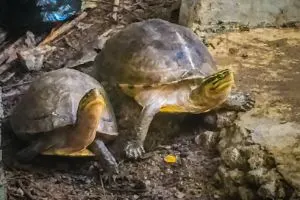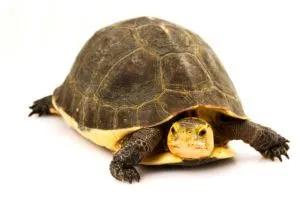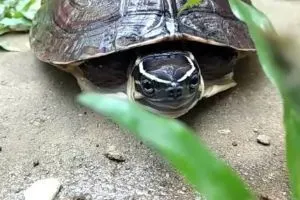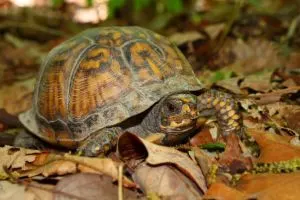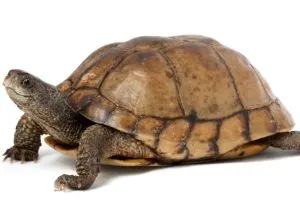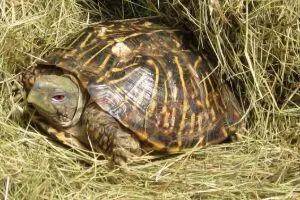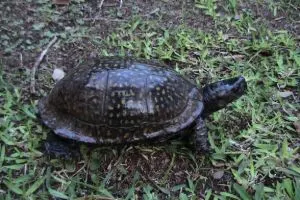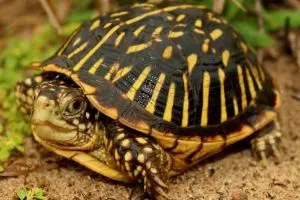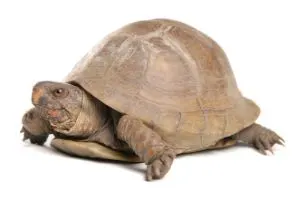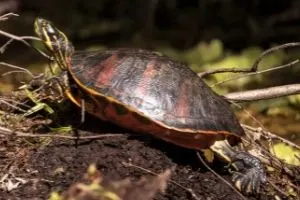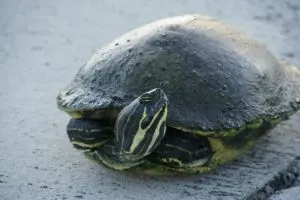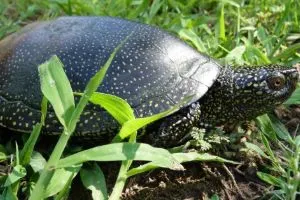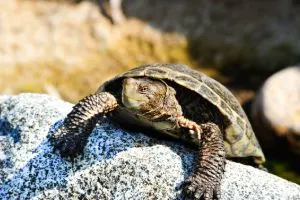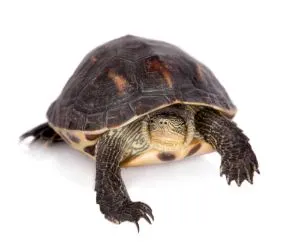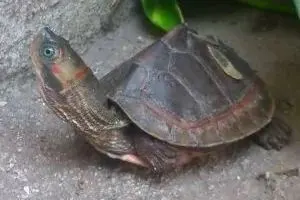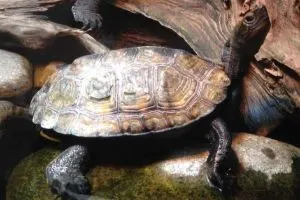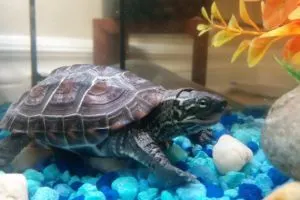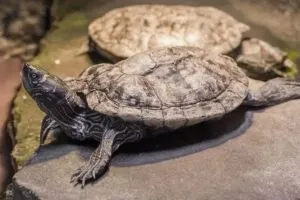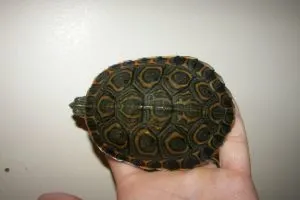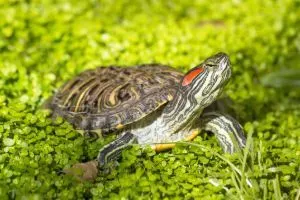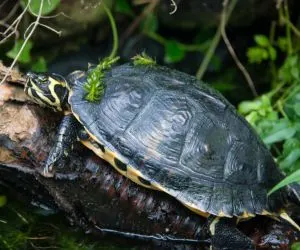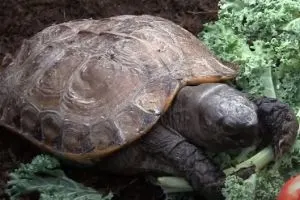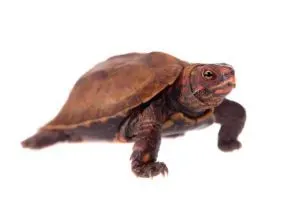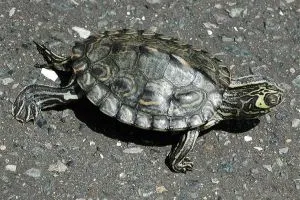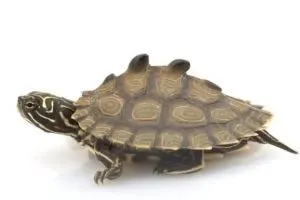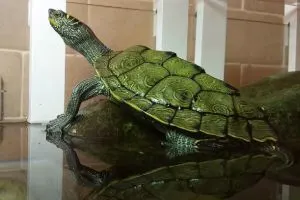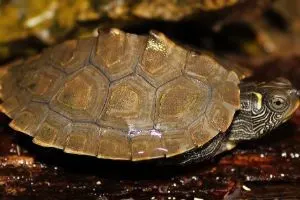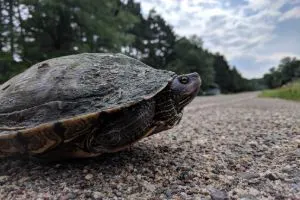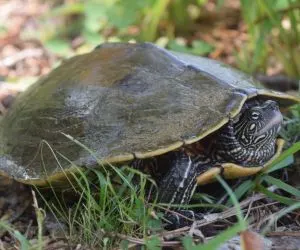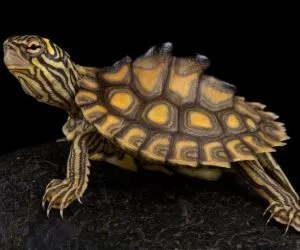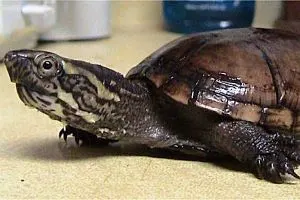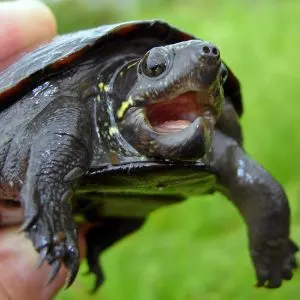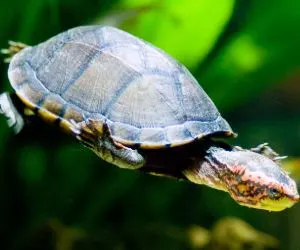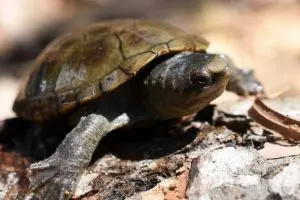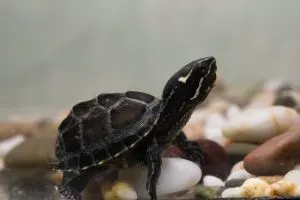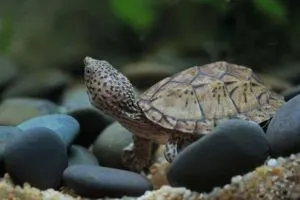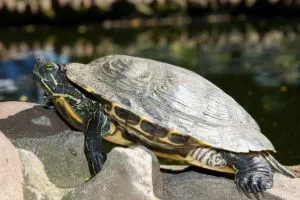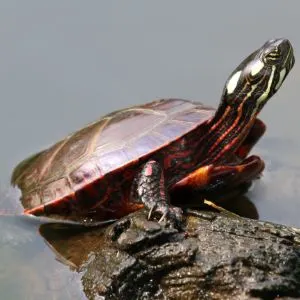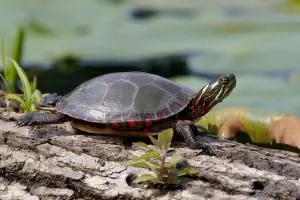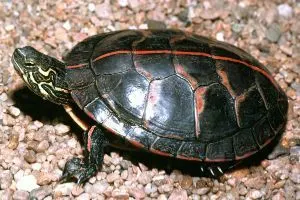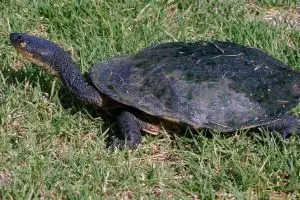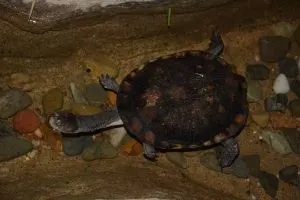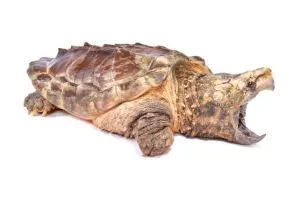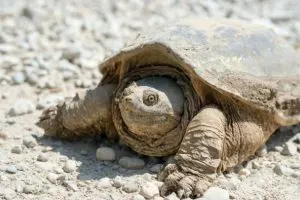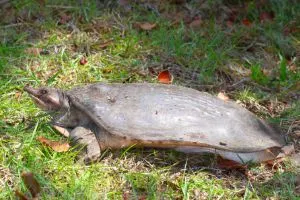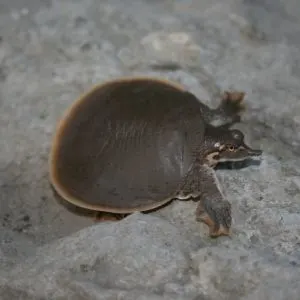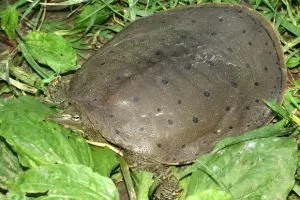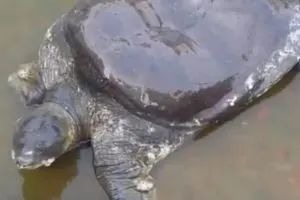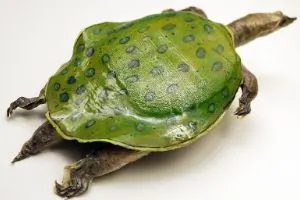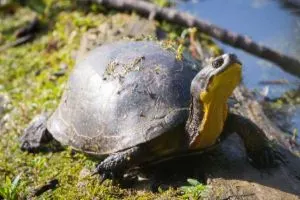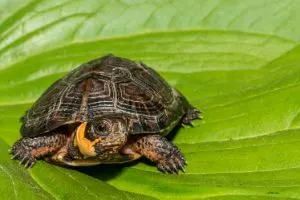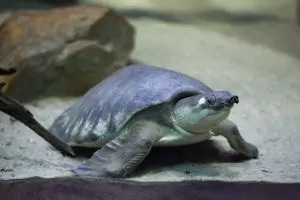Below you will find a few of the many different types of Turtle Species. In order to make filtering easy we have categorized them by different types of turtles including all of your favorites like Sliders, Box Turtles, Snapping Turtles and more!
To give you a little guidance here are a few helpful pages to get the most out of the site.
- The Top 6 Best Pet Turtles
- A Turtle Identification Guide
- How Much Do Turtles Cost? (An Overview On Ownership)
- Is Your Turtle A Boy Or Girl?
- What Do Turtles Eat?
- Differences Between Turtles And Tortoises
Whether you’re looking for a care guide on your new pet turtle, or you just want to learn more about a turtle that you spotted in the wild, this page lists several different types of Turtle Species that we’ve covered here on AllTurtles.
To help you navigate through the list, we’ve categorized each species into different types. From Box turtles to Mud turtles and from Sliders to Snapping turtles, you’ll find exactly what you’re looking for!
For land turtle care check out our tortoise species page.
Turtle Species Guide With Caresheets
Box Turtles
1. Asian Box Turtles (Overview)
- Family: Geoemydidae
- Genus: Cuora
- Binomial Name: Various
- Other Names: Various
- Type: Semi-Aquatic
- Size: 12 inches (30 cm)
- Lifespan: 100 years
Asian Box turtles are a group of 12 subspecies of Box turtles that are native to areas of Southeast Asia, including China, Indonesia, parts of India, and the Philippines.
Asian Box turtles of the Cuora genus usually have reddish to brown or even black domed shells with three distinctive keels. Many species have vibrant stripe markings running down these keels, often in colors such as yellow, orange, and white.
Most Asian Box turtles are omnivores, and can either be aquatic, semi-aquatic, or terrestrial. Unfortunately, they are also the most commonly trafficked type of turtle in the world. They are used as a food source as well as in the pet trade.
2. Chinese Box Turtle
- Family: Geoemydidae
- Genus: Cuora
- Binomial Name: Cuora flavomarginata
- Other Names: Golden-headed turtle, Yellow-margined Box turtle, Snake-eating turtle
- Type: Semi-Aquatic
- Size: 5.5 to 6.5 inches (14 to 16cm)
- Lifespan: 100 years
Chinese Box turtles are found in central areas of China, as well as in parts of Japan and Taiwan. These beautiful semi-aquatic turtles have distinctive yellow margins to their lower bodies. Their highly domed shells are a dark brown color, and they have yellow stripes on their keels.
Chinese Box turtles are omnivorous and will usually eat fruits, vegetables, mollusks, and worms. They favor subtropical climates with a high humidity and warm temperatures. These active turtles like to burrow into the ground to keep themselves humid.
3. Malaysian Box Turtle
- Family: Geoemydidae
- Genus: Cuora
- Binomial Name: Cuora amboinensis kamaroma
- Other Names: Amboina Box turtle, Southeast Asian Box turtle
- Type: Semi-Aquatic
- Size: 8 inches (20 cm)
- Lifespan: 35 years
Malaysian Box turtles are a local subspecies of the Southeast Asian Box turtle, also known as the Amboina Box turtle. This particular subspecies is found in regions of Indochina, including Malaysia, Singapore, Thailand, and Vietnam.
Malaysian Box turtles prefer tropical habitats with warm water and high humidity. They have dark brown shells with fewer black spot patterns than other Southeast Asian Box turtles. Malaysian Box turtles also have shorter and smaller tails than their cousins.
These turtles can survive in some pretty extreme conditions, but are unfortunately Endangered. Malaysian Box turtles are omnivores, although older individuals will eat more vegetation.
4. Box Turtle (Overview)
- Family: Emydidae
- Genus: Terrapene
- Binomial Name: Various
- Other Names: Various
- Type: Terrestrial
- Size: 6 to 8 inches (15 to 20cm)
- Lifespan: 50 to 100 years
Box turtles are a group of six mainly semi-aquatic turtles that are endemic to North America. Across the six types, there are also 12 subspecies of Box turtles that can be found. Although they like a range of different habitats, most Box turtles will prefer temperate forests.
Different types of Box turtles hold different conservation statuses, but most species can be easily stressed and struggle to adapt to new environments. This has caused some species to become endangered. Most Box turtles are omnivores.
Box turtles commonly have dark brown to green shells that sport beautiful and intricate markings. The colors for these patterns can range from orange to yellow.
See our Box Turlte Species page for more types.
5. Coahuilan Box Turtle
- Family: Emydidae
- Genus: Terrapene
- Binomial Name: Terrapene coahuila
- Other Names: Aquatic Box turtle
- Type: Aquatic
- Size: 3-6in (15-20 cm)
- LifeSpan: 65 years
Coahuilan Box turtles are the most endangered type of Box turtle. They are endemic to the area surrounding the city of Cuatro Cienegas in the Coahuila region of Mexico. Unlike virtually every other Box turtle, the Coahuilan Box turtle is almost completely aquatic.
Coahuilan Box turtles have dark brown to black shells without distinctive markings. Because they live mostly in water, their shells can carry a lot of algae. They inhabit springs in the desert of their small region and are opportunistic omnivores.
6. Desert Box Turtle
- Family: Emydidae
- Genus: Terrapene
- Trinomial Name: Terrapene ornata luteola
- Other Names:Sonoran Box turtle
- Type: Semi-aquatic
- Size: 4-5in (10-13 cm)
- LifeSpan: 30-40 years
- States: Arizona, New Mexico, Texas
Desert Box turtles are a subspecies of Box turtle that has adapted to living in more arid, open habitats. The Desert Box turtle is native to only the southwestern regions of the United States and northern parts of Mexico. They spend most of their time on land.
Desert Box turtles have dome-shaped shells that range from brown to reddish-brown. These semi-aquatic turtles have thinner markings than Ornate Box turtles. Desert Box turtles are omnivores and mainly feed on insects like grasshoppers. They will also eat vegetation such as cacti, plants, and fruit.
7. Eastern Box Turtle
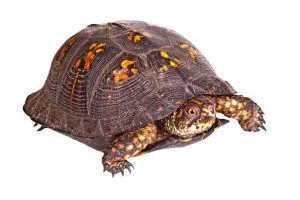
- Family: Emydidae
- Genus: Terrapene
- Trinomial Name: Terrapene carolina carolina
- Other Names: Land turtle
- Type: Semi-aquatic
- Size: 4-7in (10-18 cm)
- LifeSpan: 65 years
- States: Alabama, Connecticut, Delaware, Florida, Georgia, Illinois, Indiana, Kansas, Kentucky, Maine, Maryland, Massachusetts, Michigan, Mississippi, New Hampshire, New Jersey, New York, North Carolina, Ohio, Pennsylvania, Rhode Island, South Carolina, Tennessee, Virginia, West Virginia
Eastern Box turtles are a colorful subspecies of the Common Box turtle. Their high domed dark brown shells sport distinctive yellow and orange markings. Their plastrons are also dark brown. Eastern Box turtles have the unique ability to regenerate their shells.
These largely terrestrial turtles can roam up to 50 meters a day in search of food, preferring woodland regions along with grasslands and marshy areas in eastern and central parts of the U.S. They stay close to ponds and streams. Eastern Box turtles are omnivores will eat fish and invertebrates as well as plants.
8. Gulf Coast Box Turtle
- Family: Emydidae
- Genus: Terrapene
- Trinomial Name: Terrapene carolina major
- Other Names: N/A
- Type: Semi-aquatic
- Size: 6 to 8.5 inches (15 to 21.5 cm)
- LifeSpan: 30 to 40 years
- States: Florida, Georgia
Gulf Coast Box turtles are the largest of the Common Box turtle subspecies, reaching up to 8.5 inches in length. They are found in brackish waters, estuaries, and swamps around the Gulf of Mexico. This semi-aquatic species prefers warm, humid areas.
Gulf Coast Box turtles have dark brown or black shells with fluted edges and yellow dot or stripe markings. The intensity of these markings can vary wildly from turtle to turtle. Gulf Coast Box turtles are omnivores, and will eat anything from carrion to insects, as well as mollusks and worms.
9. Ornate Box Turtle
- Family: Emydidae
- Genus: Terrapene
- Trinomial Name: Terrapene ornata ornata
- Other Names: Box tortoise, Western Box turtle
- Type: Aquatic
- Size: 4-5in (10-13 cm)
- LifeSpan: 30 to 40 years
- States: Arizona, Arkansas, Colorado, Illinois, Indiana, Iowa, Kansas, Louisiana, Missouri, Nebraska, New Mexico, Oklahoma, South Dakota, Texas, Wisconsin, Wyoming
Ornate Box turtles are a beautiful, colorful species. The distinctive patterning on their dark brown or black shells forms a series of yellow to orange stripes. The Ornate Box turtle is the state reptile of Kansas and can be found across much of the central and western United States.
Ornate Box turtles are largely terrestrial, preferring open habitats such as grasslands or prairies, especially in the Great Plains region. These diurnal, omnivorous turtles spend much of their time foraging for food. They have relatively small territories but have recently faced population decline due to habitat loss and the pet trade.
10. Three-toed Box Turtle
- Family: Emydidae
- Genus: Terrapene
- Trinomial Name: Terrapene carolina triunguis
- Other Names: Box turtle
- Type: SemiAquatic
- Size: 4-5in (10-13 cm)
- LifeSpan: 30-40 years
- States: Arkansas, Florida, Georgia, Louisiana, Mississippi, Missouri, Oklahoma, Tennessee, Texas
Three-toed Box turtles are a subspecies of the Eastern Box turtle found in Central and Southern areas of the United States. The Three-toed Box turtle is the state reptile of Missouri. These turtles prefer grassland areas such as meadows as well as woodland, and can adapt well to changes in habitat.
Three-toed Box turtles have high domed carapaces which are usually brown or olive in color. They also have three claws on their hind-legs, as their name implies, rather than four. Their plastrons are yellowish in color. Three-toed Box turtles are omnivores; eating insects, mollusks, worms, and vegetation.
Chicken Turtles
11. Chicken Turtle
- Family: Emydidae
- Genus: Deirochelys
- Trinomial Name: Deirochelys reticularia reticularia (Eastern) + Deirochelys reticularia miaria (Western)
- Other Names: American Snake-necked turtle
- Type: Semi-aquatic
- Size: 10 inches (25cm)
- Lifespan: 15 to 20 years
- States: Alabama, Arkansas, Florida, Georgia, Louisiana, Mississippi, Missouri, North Carolina, Oklahoma, South Carolina, Texas, Virginia
Two types of Chicken turtles make their home across the United States; the Eastern Chicken turtle and the Western Chicken turtle. Both species are semi-aquatic, preferring slow-moving waters such as lakes and ponds. Chicken turtles were named due to the taste of their flesh, which was a popular food source in Southern states.
Both types of Chicken turtle have long, striped necks and oval-shaped shells. Coloring ranges from brown to olive ringed with yellow, with markings similar to the pattern of a net. Chicken turtles are omnivores who mainly feed on amphibians, crustaceans, insects, and small fish as well as plants. They hunt within dense vegetation.
Cooters, Pond turtles, and Sliders
12. Eastern River Cooter
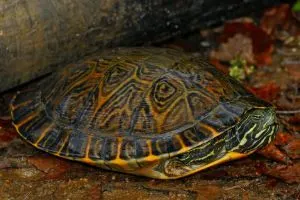
- Family: Emydidae
- Genus: Pseudemys
- Binomial Name: Pseudemys concinna concinna
- Other Names: N/A
- Type: Aquatic
- Size: 8 to 12 inches (20 to 30 cm)
- Lifespan: 20 to 40 years
- States: Alabama, Arkansas, Florida, Georgia, Illinois, Indiana, Kansas, Kentucky, Louisiana, Missouri, North Carolina, South Carolina, Tennessee, Virginia, West Virginia
Eastern River Cooters are freshwater semi-aquatic turtles that can be found across the Eastern and Midwestern regions of the United States. They can sometimes be seen basking on logs or rocks at the edge of the water. These medium-sized turtles prefer fast-moving waters in lakes, rivers, and streams and can breathe underwater.
Eastern River Cooters have slightly domed shells ranging from brown to olive. Their shells and heads have beautiful yellowish markings, while their plastrons are also yellow. These Cooters prefer a herbivorous diet of aquatic vegetation and fruits.
13. Florida River Cooter
- Family: Emydidae
- Genus: Pseudemys
- Binomial Name: Pseudemys nelsoni
- Other Names: Florida Red-bellied turtle
- Type: Aquatic
- Size: 8 to 15 inches (20 to 38 cm)
- Lifespan: 40 years
- States: Florida, Georgia
The Florida Red-bellied Cooter is a subspecies of Cooter endemic to Florida and parts of Georgia. These medium-sized Cooters have distinctive red plastrons, although this color fades as they become adults. They have brown dome-shaped shells and yellow stripes running across their bodies.
Florida Red-bellied Cooters can be seen in most waterways across their native range and are close relatives of the Peninsula Cooter. With their herbivorous diet, Florida Red-bellied Cooters mainly eat aquatic vegetation and algae.
14. Peninsula Cooter
- Genus: Pseudemys
- Binomial Name: Pseudemys peninsularis
- Other Names: N/A
- Type: Aquatic
- Size: 9 to 13 inches (23 to 33 cm)
- Lifespan: 30 years
- States: Florida
The Peninsular Cooter is a close-relative of the Coastal Plains/Florida Cooter and is endemic to the Florida Peninsular, where it can be found in most types of water. The Peninsular Cooter has a yellowish plastron and is covered in yellow stripes across its body. Like most Cooters, the Peninsular Cooter is herbivorous and feeds on aquatic vegetation.
15. European Pond Turtle
- Family: Emydidae
- Genus: Emys
- Binomial Name: Emys orbicularis
- Other Names: European Pond terrapin, European Pond tortoise
- Type: Semi-aquatic
- Size: 5 to 15 inches (13 to 38 cm)
- Lifespan: 40 to 60 years
European Pond turtles are found across Europe, the Mediterranean, and North Africa. There are about 14 recognized regional subspecies. Across its range, the European Pond turtle inhabits wetland areas with woodland cover. These semi-aquatic turtles can sometimes travel up to 2.5 miles away from the water in search of food.
European Pond turtles are usually a uniform dark-brown color, with yellow spots running along the rim. They eat an omnivorous diet, particularly when young. European Pond turtles will eat amphibians, small fish, insects, mollusks, worms, and vegetation.
16. Western Pond Turtle
- Family: Emydidae
- Genus: Actinemys
- Binomial Name: Actinemys marmorata
- Other Names: Pacific Pond Turtle
- Type: Aquatic
- Size: 4 to 8 inches (11 to 21 cm)
- Lifespan: 40 to 50 years
- States: California, Nevada, Oregon, Washington
Western Pond turtles are an endangered species that is endemic to the Pacific Northwest and the northwestern coast of Mexico. Populations are declining across this range. Western Pond turtles have dark brown to olive shells with cream or lightly colored fleck markings. They have yellow plastrons with dark markings as well as brown spotted skin.
Western Pond turtles are an aquatic species inhabiting lakes and ponds and sometimes brackish waters. They are shy and secretive omnivores who mainly consume fish, worms, insects, and occasionally plants.
17. Golden Thread Turtle
- Family: Geoemydidae
- Genus: Mauremys
- Binomial Name: Mauremys sinensis
- Other Names: Chinese Stripe-necked turtle
- Type: Semi-aquatic
- Size: 6 to 12 inches (15 to 30 cm)
- Lifespan: 60 years
Golden Thread turtles are endemic to parts of Asia such as China, Laos, Taiwan, and Vietnam. This endangered species inhabits slow-moving waters in low altitude areas. They eat an omnivorous diet, although older turtles will eat more vegetation.
Golden Thread turtles have brown shells and ivory plastrons. When young, their shells have three ridges, but two of these disappear as the turtle ages. These turtles also have dark horizontal stripes running down their necks and shoulders.
18. Indian Tent Turtle
- Family: Geoemydidae
- Genus: Pangshura
- Binomial Name: Pangshura tentoria
- Other Names: Indian Pink-ringed Tent turtle
- Type: Semi-aquatic
- Size: 3 to 9 inches (8 to 23 cm)
- Lifespan: 10 to 15 years
Indian Tent turtles are a small semi-aquatic species native to Bangladesh and India. They get their name from their tent-shaped shells, which are usually dark brown in color. Indian Tent turtles also have reddish dots behind their eyes and pink bands running along their shells.
Indian Tent turtles prefer freshwater river and swamp habitats, especially larger waterways. They have an omnivorous diet of crustaceans, insects, mollusks, worms, and vegetation.
19. Japanese Pond Turtle
- Family: Geoemydidae
- Genus: Mauremys
- Binomial Name: Mauremys japonica
- Other Names: Japanese turtle, Japanese Stone turtle
- Type: Aquatic
- Size: 5 to 8 inches (13 to 20 cm)
- Lifespan: 20+ years
The Japanese Pond turtle is endemic to Japan, where it is known as “Nihon Ishigame”. This aquatic species prefers the colder waters of the Japanese islands, where they also hibernate in the depths. They are a popular pet species in Japan, but also across the world.
Japanese Pond turtles have shell coloration ranging from black to brown to a yellowish-brown. A single ridge with a serrated rear runs along their shells. Orange stripes are visible on the sides of their legs. This is an omnivorous species that favors amphibians, crustaceans, insects, worms, and aquatic vegetation.
20. Reeves Turtle
- Family: Geoemydidae
- Genus: Mauremys
- Binomial Name: Mauremys reevesii
- Other Names: Chinese Pond turtle, Chinese Three-keeled Pond turtle
- Type: Semi-aquatic
- Size: 6 to 9 inches (15 to 23 cm)
- Lifespan: 10 to 20 years
The Chinese Pond turtle, also known as the Reeves turtle after English naturalist John Reeves, is found across parts of eastern Asia such as China, Korea, and Japan. This semi-aquatic species prefers slower-moving waters such as marshes or ponds, often with muddy substrates.
Chinese Pond turtles have a slightly rectangular shell that ranges from dark green to olive. They have yellowish plastrons. These turtles face several challenges including habitat loss, farming for traditional Chinese medicine, and capture for the pet trade. This is an omnivorous species that eats insects, worms, and small fish along with aquatic plants.
21. Cumberland Slider
- Family: Emydidae
- Genus: Trachemys
- Trinomial Name: Trachemys scripta troostii
- Other Names: Cumberland turtle, Troost’s turtle
- Type: Semi-aquatic
- Size: 7 to 11 inches (18 to 29cm)
- Lifespan: 50 years
- States: Georgia, Tennessee, Virginia
A close relative of both the Red-eared and Yellow-bellied Sliders, Cumberland Sliders are found in the southeastern United States, mainly in the drainages of the Cumberland River. They prefer slow-moving waters with muddy depths and plenty of vegetation.
Cumberland Sliders have shells ranging from brown to olive green and have yellow markings. This species has a bland appearance compared to other Sliders. This medium-sized aquatic species is omnivorous. They eat a natural diet of insects, mollusks, worms, turtle pellets, and vegetation. They can sometimes be seen basking in communal groups.
22. Nicaraguan Slider
- Family: Emydidae
- Genus: Trachemys
- Binomial Name: Trachemys emolli
- Other Names: Peacock Slider
- Type: Aquatic
- Size: 10 to 15 inches (25 to 38 cm)
- Lifespan: 20 to 30 years
Nicaraguan Sliders are endemic to both Costa Rica and Nicaragua in South America, and are mainly found in lakes and streams. They are a popular species in the pet trade, and their shells are often painted and sold to tourists. In the wild, these Sliders live solitary lives for most of the year.
These colorful Sliders are also known as Peacock Sliders thanks to their vibrant coloration. Their oval-shaped shells are olive green and are covered with distinctive blue, green, and yellow markings. Nicaraguan Sliders are omnivorous, consuming amphibians, insects, mollusks, worms, and plant matter.
23. Red-eared Slider
- Family: Emydidae
- Genus: Trachemys
- Trinomial Name: Trachemys scripta elegans
- Other Names: Red-eared terrapin, Water Slider
- Type: Semi-aquatic
- Size: 6 to 10 inches (15 to 25 cm)
- Lifespan: 30 years
- States: Alabama, Arizona, Arkansas, California, Delaware, Florida, Georgia, Hawaii, Illinois, Indiana, Iowa, Kansas, Kentucky, Louisiana, Maryland, Massachusetts, Michigan, Minnesota, Mississippi, Missouri, Nebraska, Nevada, New Jersey, New Mexico, North Carolina, Ohio, Oklahoma, Oregon, Tennessee, Texas, Virginia, Washington, West Virginia, Wyoming
The Red-eared Slider is one of the most widespread turtle species in the United States. In some areas, these semi-aquatic turtles are considered to be an invasive species due to the unsafe release of captive specimens. This is because Red-eared Sliders are one of the most popular turtles in the pet trade and are extremely easy to acquire.
Red Eared Sliders commonly have an olive green shell, with yellowish striped markings on their scales. Their heads are usually a darker color, with yellow band markings and red patches just behind their eyes. They prefer warm, slow-moving waters such as rivers and lakes. Their omnivorous diet consists of small fish, aquatic invertebrates, and underwater vegetation.
24. Yellow-bellied Slider
- Family: Emydidae
- Genus: Trachemys
- Trinomial Name: Trachemys scripta scripta
- Other Names: N/A
- Type: Semi-aquatic
- Size: 5 to 13 inches (13 to 33 cm)
- Lifespan: 25+ years
- States: Alabama, Florida, Georgia, Kansas, Maryland, Mississippi, North Carolina, South Carolina, Tennessee, Virginia
Yellow-bellied Sliders are a semi-aquatic species found mainly in the southeastern United States. They inhabit wetland habitats such as lakes and rivers and can sometimes be seen wandering on land as they move between habitats or basking on the shore.
As their name implies, these turtles have yellowish plastrons, as well as yellow markings across their skin. Yellow-bellied Sliders also have prominent yellow stripes behind their eyes. Their shells range from dark brown to olive. These diurnal omnivores mainly eat plant matter along with insects, mollusks, small fish, and worms.
25. Arakan Forest Turtle
- Family: Geoemydidae
- Genus: Heosemys
- Binomial Name: Heosemys depressa
- Other Names: Arakan turtle
- Type: Semi-terrestrial
- Size: 11 inches (28 cm)
- Lifespan: Unknown
Arakan Forest turtles are one of the rarest and most endangered turtles in the world. Natives of Bangladesh and Myanmar, not much is known about this species. They are nocturnal foragers, eating an omnivorous diet of fish, insects, mollusks, worms, and fruit and vegetation.
They spend much of the day hiding under leaves. Arakan turtles have light brown to gray shells with some irregular dark markings. They have long limbs and large claws which they use for feeding. They live within specific bamboo forests in their native range. Up until 1994 these turtles were believed to be extinct.
26. Philippine Forest Turtle
- Family: Geoemydidae
- Genus: Siebenrockiella
- Binomial Name: Siebenrockiella leytensis
- Other Names: Leyte Pond turtle, Palawan turtle, Philippine Pond turtle
- Type: Semi-aquatic
- Size: 8 to 12 inches (21 to 30 cm)
- Lifespan: Unknown, but appears to be long-lived
Philippine Forest turtles are endemic to the Philippine Islands, especially Palawan. These mysterious turtles are critically endangered, with little being known about them. Their shells are dark brown, with distinctive front scutes shaped like ginkgo leaves. A white or yellow line runs around the turtle’s head. The Philippine Forest turtle is one of the largest species of the Geoemydidae family in the Philippines.
The Philippine Forest turtle relies on mangrove and swamp habitats, which put it at risk from habitat loss. These semi-aquatic turtles are nocturnal and hide under rocks during the day. They eat an omnivorous diet of crustaceans, insects, and fish as well as fruits and plants.
Leaf Turtles
27. Leaf Turtle Overview
- Family: Geoemydidae
- Genus: Geoemyda
- Binomial Name: Various
- Other Names: Various
- Type: Aquatic
- Size: 4 to 9 in (10 to 23 cm)
- Lifespan: 20 years
Leaf turtles are a group of mainly aquatic turtles found across Asia. Leaf turtles are named for the mottled leaf-like patterns found on their shells. Many subspecies of Leaf turtles are small, with some species only reaching an average length of 4 inches.
In the past they have been common to the pet trade, but a reliance on imports has meant serious health issues for many specimens. Leaf turtles can be captive-bred, but are extremely sensitive and difficult to have success with.
28. Black-breasted Leaf Turtle
- Family: Geoemydidae
- Genus: Geoemyda
- Binomial Name: Geoemyda spengleri
- Other Names: Black-breasted Hill turtle, Vietnamese Leaf turtle
- Type: Aquatic
- Size: 3 to 4 inches (7 to 11 cm)
- Lifespan: 20 years
Black-breasted Leaf turtles are native to parts of Southeast Asia including southern China and northern Vietnam. These turtles have striking eyes and beautiful coloration on their shells, ranging from dark green to olive with mottled patterns that resemble a leaf. Black-breasted Leaf turtles also have three ridges running down their keels, with dark or black plastrons.
Black-breasted Leaf turtles like to hide under leaf litter in their natural habitats within Asian forests. They eat an omnivorous diet of insects, mollusks, worms, and fruits and plant material. This species is unfortunately classed as endangered thanks to collection for the pet trade.
Map Turtles
29. Alabama Map Turtle
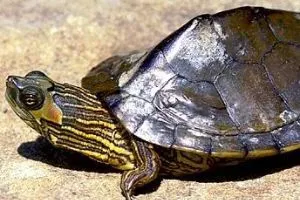
- Family: Emydidae
- Genus: Graptemys
- Binomial Name: Graptemys pulchra
- Other Names: N/A
- Type: Aquatic
- Size: 3.5 inches to 11.5 inches (9 to 30 cm)
- Lifespan: 15 years
- States: Alabama, Georgia, Mississippi
Alabama Map turtles are endemic to a small area of the Southeastern United States, mainly around Alabama, Georgia, and Mississippi. They can be found in river drainages but are considered to be a species under threat. Females are usually twice the size of males.
Like other Map turtles, Alabama Map turtles have dark to olive green shells with yellow contour-like markings. To distinguish them from other species, Alabama Map turtles also have black stripes running down the center of their backs. These turtles usually eat mollusks, shellfish, and worms.
30. Barbour’s Map Turtle
- Family: Emydidae
- Genus: Graptemys
- Binomial Name: Graptemys barbouri
- Other Names: N/A
- Type: Aquatic
- Size: 3.5 to 5.5 inches (9 to 14 cm)
- Lifespan: 30 years
- States: Alabama, Florida, Georgia
Barbour’s Map turtles are found in a small range of fast-moving river systems around southeast Alabama, southwest Georgia, and the Florida Panhandle. Barbour’s Map turtles have black-tipped saw-toothed keels and yellow crescent markings on the edges of their shells.
Barbour’s Map turtles are mainly carnivorous, eating crustaceans and mollusks found in the rivers. They spend virtually their entire lives underwater, apart from the larger females who nest on land. This species is considered vulnerable due to habitat loss.
31. Black-knobbed Map Turtle
- Family: Emydidae
- Genus: Graptemys
- Binomial Name: Graptemys nigrinoda
- Other Names: Black-knobbed Sawback
- Type: Aquatic
- Size: 3.5 to 8 inches (9 to 20 cm)
- Lifespan: 20 to 30 years
- States: Alabama, Mississippi
Black-knobbed Map turtles are a distinctive subspecies, with protruding knob-like keels with black tips. These aquatic turtles also have gray skin and darker green shells compared to most other species of Map turtle. Their dark brown heads sport yellow stripes.
Black-knobbed Map turtles are found in river systems in Alabama and Mississippi and can only survive in true freshwater habitats. They have a mainly carnivorous diet of insects, mollusks, and worms. The Black-knobbed Map turtle is considered Near Threatened.
32. Cagle’s Map Turtle
- Family: Emydidae
- Genus: Graptemys
- Binomial Name: Graptemys caglei
- Other Names: N/A
- Type: Aquatic
- Size: 3 to 10 inches (7.5 to 25.5 cm
- Lifespan: 30 to 50 years
- States: Texas
Named after herpetologist Dr. Fred Ray Cagle, the Cagle’s Map turtle is one of the smaller subspecies and is endemic to the rivers of Texas. It is mainly found in counties south of the Guadalupe River, including areas around the San Antonio and San Marcos rivers.
Cagle’s Map turtles look similar to other Map turtles, with dark shells that have steep keels and serrated rears. Cagle’s Map turtles have cream to yellowish stripes on their heads and intricate contour markings on their shells. Cagle’s Map turtles are omnivores, consuming insects, mollusks, and occasionally vegetation.
33. False Map Turtle
- Family: Emydidae
- Genus: Graptemys
- Binomial Name: Graptemys pseudogeographica
- Other Names: Sawback turtle
- Type: Aquatic
- Size: 3.5 to 10 inches (9 to 27 cm)
- Lifespan: 30 to 50 years
- States: Alabama, Arkansas, Florida, Illinois, Indiana, Iowa, Kansas, Kentucky, Louisiana, Minnesota, Mississippi, Missouri, Nebraska, North Dakota, Ohio, Oklahoma, South Dakota, Tennessee, Texas, Wisconsin
The False Map turtle is a subspecies of Map turtle found throughout the Midwest of the United States. It dwells mainly in the larger river systems across the region such as the Mississippi. False Map turtles have dark green shells with pronounced saw-like keels. They have contour-like yellow markings and dark blotches as a pattern.
To distinguish themselves from other Map turtles, False Map turtles lack colored patches on their heads. False Map turtles rarely travel far from the water, and like to bask on outcrops over the water surface. This species is omnivorous and eats aquatic invertebrates, crayfish, and aquatic plants.
34. Mississippi Map Turtle
- Family: Emydidae
- Genus: Graptemys
- Trinomial Name: Graptemys pseudogeographica kohni
- Other Names: Sawback turtle
- Type: Aquatic
- Size: 3.5 to 10 inches (9 to 27 cm)
- Lifespan: 30 to 50 years
- States: Arkansas, Iowa, Kentucky, Louisiana, Minnesota, Mississippi, Missouri, Tennessee, Wisconsin
The Mississippi Map turtle is a subspecies of the False map turtle and inhabits waterways along the path of the Mississippi River. This aquatic species rarely travels far from the water, often basking on rocks overlooking the surface.
Mississippi Map turtles have dark brown or black shells with contour-like yellow markings. Most adults have a series of sharp black-tipped keels running the length of their shells. They are omnivores and eat aquatic invertebrates, crayfish, and underwater vegetation.
35. Northern Map Turtle
- Family: Emydidae
- Genus: Graptemys
- Binomial Name: Graptemys geographica
- Other Names: Common Map turtle
- Type: Aquatic
- Size: 4 to 6 inches (10 to 15 cm)
- Lifespan: 15 to 20 years
- States: Alabama, Arkansas, Georgia, Illinois, Indiana, Iowa, Kansas, Kentucky, Maryland, Michigan, Minnesota, Missouri, New Jersey, New York, Ohio, Oklahoma, Pennsylvania, Tennessee, Vermont, Virginia, West Virginia, Wisconsin
The Northern Map turtle is one of the most widespread subspecies of Map turtles, and is found across the Central and Eastern United States. They mainly inhabit river systems and rarely venture far from the water. These turtles are mainly carnivorous, feeding on fish and aquatic invertebrates like crayfish, but also occasionally eat plants.
Common Map turtles have dark brown or olive green shells, and are named for their markings, which resemble the contours of a map and are often yellow in color. Small yellow spots behind the eyes separate the Common Map turtle from other subspecies.
36. Ouachita Map Turtle
- Family: Emydidae
- Genus: Graptemys
- Binomial Name: Graptemys ouachitensis
- Other Names: N/A
- Type: Aquatic
- Size: 3.5 to 10 inches (9 to 25 cm)
- Lifespan: 15 to 20 years
- States: Alabama, Arkansas, Illinois, Indiana, Iowa, Kansas, Kentucky, Louisiana, Minnesota, Mississippi, Missouri, Ohio, Oklahoma, Tennessee, Texas, West Virginia, Wisconsin
Ouachita Map turtles are a type of Map turtle that is endemic to the Midwestern United States. Ouachita Map turtles can be distinguished from other Map turtles by the large lightly colored patches behind their eyes. Males have a prominent keel protruding from their dark green shells.
These diurnal turtles inhabit river systems and drainages and can be seen basking. Ouachita Map turtles are omnivores, mainly eating aquatic larvae, insects, mollusks, and shrimp. They will also occasionally eat algae and aquatic plants.
37. Texas Map Turtle
- Family: Emydidae
- Genus: Graptemys
- Binomial Name: Graptemys versa
- Other Names: N/A
- Type: Aquatic
- Size: 3.5 to 5 inches (9 to 13 cm)
- Lifespan: 30 to 50 years
- States: Texas
One of the smaller subspecies of Map turtle, Texas Map turtles are endemic to Texas and are found in fast-moving waters that flank the Colorado River. Texas Map turtles have shells which vary between brown to olive, covered with yellow patterns similar to the contours of a map. Texas Map turtles also have spiked keels.
Texas Map turtles can be distinguished from other Map turtles by a series of three yellow or orange spots that run along the bottom of their heads. They are omnivores and mainly eat insects, aquatic invertebrates, and plants.
38. Yellow-blotched Map Turtle
- Family: Emydidae
- Genus: Graptemys
- Binomial Name: Graptemys flavimaculata
- Other Names: Yellow-blotched Sawback
- Type: Aquatic
- Size: 3 to 7 inches (7.5 to 18 cm)
- Lifespan: 30 to 50 years
- States: Mississippi
Yellow-blotched Map turtles are a rare species of Map turtle endemic to the Pascagoula River in Mississippi. Because of their incredibly specific habitat, this species is listed as Threatened.
Yellow-blotched Map turtles can be identified by their pronounced central keel, which is the highest keel of any species of Map turtle. These omnivorous turtles mainly eat crustaceans, insects, fish, and occasionally vegetation.
Mud Turtles
39. Mud Turtle Overview
- Family: Kinosternidae
- Genus: Kinosternon
- Binomial Name: Various
- Other Names: Various
- Type: Aquatic
- Size: 5 to 10 inches (13 to 25 cm)
- Lifespan: 10 to 50 years
Mud turtles are a group of mainly aquatic turtles that are endemic to the United States and Central America. These small turtles can be found in slow-moving waters with muddy or silty bottoms and are similar to Musk turtles. However, Mud turtles are generally smaller and have flatter domed shells compared to Musk turtles.
Due to their small size and relative ease of care, Mud turtles are a common type of pet turtle in the hobby. Most Mud turtle species are carnivores, feasting on crustaceans, insects, small fish, mollusks, worms, and sometimes carrion.
40. Mississippi Mud Turtle
- Family: Kinosternidae
- Genus: Kinosternon
- Trinomial Name: Kinosternon subrubrum hippocrepis
- Other Names: N/A
- Type: Semi-aquatic
- Size: 3 to 4.5 inches
- Lifespan: 30 to 50 years
- States: Arkansas, Georgia, Louisiana, Mississippi, Oklahoma
Mississippi Mud turtles are one of two subspecies of the Common or Eastern Mud turtle and are found in muddy-bottomed stagnant waters of the Mississippi River. They spend more time on land than most other Mud or Musk turtles, and aren’t the best swimmers. They don’t bask often but are more active after rainstorms.
Mississippi Mud turtles are small and have dark colored shells; often brown or black. Their plastrons are yellow with brown blotches. Mississippi Mud turtles can be distinguished by yellow bands that run down the sides of their face and necks. These turtles are mainly carnivorous, eating crustaceans, insects, mollusks, and worms.
41. Red-cheeked Mud Turtle
- Family: Kinosternidae
- Genus: Kinosternon
- Trinomial Name: Kinosternon scorpioides cruentatum
- Other Names: N/A
- Type:
- Size: 7 inches (18 cm)
- Lifespan: 30 to 50 years
Red-cheeked Mud turtles are a subspecies of the Scorpion Mud turtle and are found throughout regions of South America. They prefer warmer waters with sandy or silty depths, such as lakes and rivers. They often bask by floating at or just under the surface of the water.
Red-cheeked Mud turtles have smooth domed dark brown shells. Their undersides have bright orange plastrons. This distinctive orange and red coloration continues on their faces, and is speckled with black spots. As a carnivorous species, the Red-cheeked Mud turtle consumes amphibians, crustaceans, insects, mollusks, and worms.
42. Scorpion Mud Turtle
- Family: Kinosternidae
- Genus: Kinosternon
- Binomial Name: Kinosternon scorpioides
- Other Names:
- Type: Aquatic
- Size: 3 to 11 inches (8 to 28 cm)
- Lifespan: 40 to 50 years
Scorpion Mud turtles are found throughout parts of Central and Southern America such as Mexico. These aquatic turtles will inhabit most bodies of water. Scorpion Mud turtles have shells ranging from tan to dark brown or black. Their skin is black or gray-brown with vibrant orange, red, or yellow markings on their head and neck.
Scorpion Mud turtles are ferocious carnivores and will even turn to cannibalism if necessary. They are medium-sized and will usually eat amphibians, crustaceans, insects, mollusks, worms, and even smaller reptiles.
43. Striped Mud Turtle
- Family: Kinosternidae
- Genus: Kinosternon
- Binomial Name: Kinosternon baurii
- Other Names: Three-striped Mud turtle
- Type: Aquatic
- Size: 4 to 5 inches (10 to 13 cm)
- Lifespan: 10 to 50 years
- States: Alabama, Florida, Georgia, Maryland, North Carolina, South Carolina, Virginia
Striped Mud turtles are a small species of Mud turtle that are easily identified by the three lightly colored stripes visible on their dark brown shells. Striped Mud turtles also have yellowish stripes running between their eyes and nostrils. They are found throughout the southeastern United States.
Striped Mud turtles are more active on land when foraging than most other Mud turtles, but will not bask out of the water often. They prefer shallow, slow-moving waters with soft substrates. These turtles are omnivores, mainly feasting on mollusks, worms, invertebrates, and fish as well as occasionally eating plants and algae.
44. White-lipped Mud Turtle
- Family: Kinosternidae
- Genus: Kinosternon
- Binomial Name: Kinosternon leucostomum
- Other Names: N/A
- Type: Aquatic
- Size: 8 inches (20 cm)
- Lifespan: 30 to 50 years
White-lipped Mud turtles are a medium-sized species that inhabits parts of Central and South America. They dwell in slower-moving waters such as marshes and swamps with sandy or silty bottoms. They will burrow into these substrates if the water level dips.
White-lipped Mud turtles have black to brown oval-shaped shells. They have distinctive white or cream-colored mouths and jaws. Their tails have a small horned spine. White-lipped Mud turtles are crepuscular omnivores, foraging mainly at dawn and dusk for crustaceans, fish, insects, mollusks, worms, and occasionally plant matter.
45. Yellow Mud Turtle
- Family: Kinosternidae
- Genus: Kinosternon
- Binomial Name: Kinosternon flavescens
- Other Names: Yellow-necked Mud turtle
- Type: Aquatic
- Size: 4 to 6 inches (10 to 15 cm)
- Lifespan: 10 to 50 years
- States: Arizona, Arkansas, Colorado, Illinois, Iowa, Kansas, Missouri, Nebraska, New Mexico, Oklahoma, Texas
Yellow Mud turtles are endemic to the Midwest and Southwestern United States and parts of Northern Mexico. These turtles inhabit wetland areas such as marshes and ponds and spend a fair amount of time on land. Yellow Mud turtles like to burrow and dig in sandy areas.
Yellow Mud turtles have olive-colored shells and get their name from the yellow markings around their faces. They also have yellow plastrons. Yellow Mud turtles are carnivores and mainly eat crustaceans, aquatic invertebrates, earthworms, and mollusks.
Musk Turtles
46. Musk Turtle Overview
- Family: Kinosternidae
- Genus: Sternotherus
- Binomial Name: Various
- Other Names: Various
- Type: Aquatic
- Size: 2 to 5.5 inches (5 to 14 cm)
- Lifespan: 50 years
Musk turtles are a group of small aquatic turtles that are endemic to the United States. Musk turtles are often confused with Mud turtles, but Musk turtles are usually a bit bigger and have more steeply-sloped shells. Musk turtles are a popular choice for pet turtles because of their small size.
Musk turtles are mainly carnivorous, enjoying a diet of amphibians, insects, small fish, mollusks, and worms. They will sometimes walk along the river bottom, but also like to have lots of aquatic vegetation where they can hunt their prey.
47. Common Musk Turtle
- Family: Kinosternidae
- Genus: Sternotherus
- Binomial Name: Sternotherus odoratus
- Other Names: Eastern Musk turtle, Stinkpot turtle
- Type: Aquatic
- Size: 4 to 5 inches (5 to 13 cm)
- Lifespan: 30 to 50 years
- States: Alabama, Arkansas, Connecticut, Delaware, Florida, Georgia, Illinois, Indiana, Iowa, Kansas, Kentucky, Louisiana, Maine, Maryland, Massachusetts, Michigan, Minnesota, Mississippi, Missouri, New Hampshire, New Jersey, New York, North Carolina, Ohio, Oklahoma, Pennsylvania, Rhode Island, South Carolina, Tennessee, Texas, Vermont, Virginia, West Virginia, Wisconsin
The Common Musk turtle is the most widespread of the Musk turtles in the United States. They inhabit boggy and marshy areas with slow-moving waters. Common Musk turtles are also known as Stinkpots thanks to the strong odor they can excrete from their musk glands.
Common Musk turtles have dark brown or black unmarked shells. Their heads are also dark, with two yellowish stripes as well as fleshy barbels on their chins and necks. Common Musk turtles are nocturnal omnivores and mainly eat mollusks, crustaceans and small amphibians.
48. Flattened Musk Turtle
- Family: Kinosternidae
- Genus: Sternotherus
- Binomial Name: Sternotherus depressus
- Other Names: N/A
- Type: Aquatic
- Size: 3 to 4 inches (7 to 10 cm)
- Lifespan: 50 years
- States: Alabama
The critically endangered Flattened Musk turtle is endemic to a single river drainage in Alabama; the Black Warrior River. Flattened Musk turtles are named for their flattened appearance, as if something has stepped on them.
Their shells are dark to yellowish-brown with black speckles. Flattened Musk turtles are carnivores, consuming amphibians, insects, small fish, mollusks, and worms.
49. Loggerhead Musk Turtle
- Family: Kinosternidae
- Genus: Sternotherus
- Binomial Name: Sternotherus minor
- Other Names: N/A
- Type: Aquatic
- Size: 3 to 4 inches (7 to 10 cm)
- Lifespan: 20 years
- States: Alabama, Florida, Georgia, Kentucky, Louisiana, Mississippi, North Carolina, Tennessee, Virginia
Loggerhead Musk turtles are named for their relatively large heads compared to other Musk turtles. They usually inhabit ponds and rivers as well as wetlands. The Stripe-necked Musk turtle (Sternotherus minor peltifer) is a subspecies of the Loggerhead Musk turtle.
Loggerhead turtles have shells that range from brown to tan and sport dark spots. Their head and skin are usually brown, with prominent yellowish stripe markings running along the head and neck. These little turtles are carnivores who mainly feed on crustaceans, insects, mollusks, and occasionally plants.
50. Razor-backed Musk Turtle
- Family: Kinosternidae
- Genus: Sternotherus
- Binomial Name: Sternotherus carinatus
- Other Names: N/A
- Type: Aquatic
- Size: 6 inches (15 cm)
- Lifespan: 30 years
- States: Alabama, Arkansas, Louisiana, Mississippi, Oklahoma, Texas
Razor-backed Musk turtles are the largest type of Musk turtle. These aquatic turtles inhabit slower-moving waters such as ponds and usually hide and hunt within dense aquatic vegetation. Razor-backed Musk turtles are carnivores, preying on amphibians, crustaceans, small fish, insects, and mollusks.
Razor-backed Musk turtle shells can vary from black and brown to gray or olive. The scutes look like a series of razor-like humps, and are edged in black. Their brown or gray skin is usually covered in black dots, while black marking lines stretch across the shell.
Painted Turtles
51. Painted Turtle Overview
- Family: Emydidae
- Genus: Chrysemys
- Binomial Name: Various
- Other Names: Sun turtles
- Type: Aquatic
- Size: 4 to 10 inches (10 to 25 cm)
- Lifespan: 25 to 55 years
Painted turtles are a group of medium-sized aquatic turtles that are the most widespread species across the United States. Painted turtles inhabit shallower waters such as marshes and ponds, but are also common pet turtles. There are four subspecies found across the country in different areas.
Painted turtles are named for their beautifully colored shells and plastrons, which sport vibrant markings that look as if they’ve been painted. This species eats an omnivorous diet, although the exact foods preferred by each subspecies differ slightly.
52. Eastern Painted Turtle
- Family: Emydidae
- Genus: Chrysemys
- Trinomial Name: Chrysemys picta picta
- Other Names: Eastern Sun turtle
- Type: Aquatic
- Size: 5 to 7 inches (13 to 17 cm)
- Lifespan: 25 years
- States: Alabama, Connecticut, Delaware, Georgia, Maine, Maryland, Massachusetts, New Hampshire, New Jersey, New York, North Carolina, Pennsylvania, Rhode Island, South Carolina, Tennessee, Virginia, West Virginia
Eastern Painted turtles are the nominal subspecies of the Painted turtle. Eastern Painted turtles have dark to olive green shells with a pale bands on the fronts of the scutes and red markings around the edge of the shell. The plastrons are yellow. Eastern Painted turtles have a typical omnivorous diet.
53. Midland Painted Turtle
- Family: Emydidae
- Genus: Chrysemys
- TRinomial Name: Chrysemys picta marginata
- Other Names: Midland Sun turtle
- Type: Aquatic
- Size: 4 to 10 inches (10 to 25 cm)
- Lifespan: 30 to 40 years
- States: Alabama, Georgia, Illinois, Indiana, Kentucky, Maryland, Massachusetts, Michigan, New Hampshire, Ohio, Pennsylvania, Tennessee, Vermont, West Virginia, Wisconsin
Midland Painted turtles are found across most of the Central states of North America as well as in some Eastern and Southern states. Midland Painted turtles can be distinguished by a dark, shadow-like patch in the center of their plastrons. Midland Painted turtles favor insects as a dietary staple along with plant matter.
54. Southern Painted Turtle
- Family: Emydidae
- Genus: Chrysemys
- Trinomial Name: Chrysemys picta dorsalis
- Other Names: Southern Sun turtle
- Type: Aquatic
- Size: 4 to 6 inches (10 to 15 cm)
- Lifespan: 30 to 40 years
- States: Alabama, Arkansas, Florida, Georgia, Kentucky, Louisiana, Mississippi, Missouri, Oklahoma, Tennessee, Texas
Southern Painted turtles are the smallest subspecies of Painted turtle, and are found throughout the Southern states in floodplains and slow-moving waters. Southern Painted turtles are distinguished from other subspecies by the orange, red, or yellow stripe that runs down the spine of the carapace. Southern Painted turtles are mainly herbivores when adults.
55. Western Painted Turtle
- Family: Emydidae
- Genus: Chrysemys
- Binomial Name: Chrysemys picta
- Other Names: Western Sun turtle
- Type: Aquatic
- Size: 4 to 10 inches (10 to 25 cm)
- Lifespan: 30 to 40 years
- States: Arizona, Arkansas, California, Colorado, Idaho, Illinois, Iowa, Kansas, Minnesota, Missouri, Montana, Nebraska, Nevada, New Mexico, North Dakota, Oklahoma, Oregon, South Dakota, Texas, Utah, Washington, Wisconsin, Wyoming
Western Painted turtles are the most vibrantly colored Painted turtles, with green and red coloration on the plastron. The Western Painted turtle is also the state reptile of Colorado. This subspecies has a typical omnivorous diet that leans slightly towards plant matter.
Side-necked and Snake-necked Turtles
56. African Helmeted Turtle
- Family: Pelomedusidae
- Genus: Pelomedusa
- Binomial Name: Pelomedusa subrufa
- Other Names: African Side-necked turtle, Crocodile turtle, Marsh terrapin
- Type: Semi-aquatic
- Size: 8 inches (20 cm)
- Lifespan: 50 years
The African Helmeted turtle is often confused with the African Side-necked turtle, as they both share a common name. However, the African Helmeted turtle are a type of terrapin, whereas the African Side-necked turtle is a Mud turtle.
African Helmeted turtles are found in Sub-Saharan Africa and Yemen, where they inhabit marshes and other bodies of water. They have black or brown shells, with grayish-brown limbs and tails and yellowish to tan undersides. Their eyes are often wide and round, and their mouths look fixed in a permanent smile.
African Helmeted turtles are omnivorous, and have even been known to work in groups to bring down prey such as doves and other larger birds. African Helmeted turtles eat exclusively underwater and usually consume carrion, fish, insects, mollusks, worms, and plant matter.
57. African Side-necked Turtle
- Family: Pelomedusidae
- Genus: Pelusios
- Binomial Name: Pelusios castaneus
- Other Names: African Mud turtle, West African Mud turtle
- Type: Aquatic
- Size: 8 to 10 inches (20 to 25 cm)
- Lifespan: 50 years
The African Side-necked turtle is often mistaken for the African Helmeted turtle. However, the African Side-necked turtle is a type of fully aquatic Mud turtle commonly known as the African Mud turtle. This species is found throughout West Africa inhabiting slow-moving waters such as swamps.
The body and shell of the African Mud turtle is dark brown, with dark gray plastrons and undersides. They may sport a mottled pattern on top of their head. African Mud turtles have wide eyes and smiling mouths, giving them a permanently happy appearance.
These turtles are omnivores that consume amphibians, aquatic insects, crustaceans, mollusks, worms, and aquatic vegetation.
58. Pink-bellied Side-necked Turtle
- Family: Chelidae
- Genus: Emydura
- Binomial Name: Emydura subglobosa
- Other Names: Jardine River turtle, Red-bellied Short-necked turtle
- Type: Aquatic
- Size: 5 to 10 inches (12 to 25 cm)
- Lifespan: 50+ years
Pink-bellied Side-necked turtles hail from tropical regions of Australia and Papua New Guinea. These colorful turtles have distinctive pink or reddish plastrons, with relatively flat green or brown shells. They also have two bright yellow cheek stripes.
Pink-bellied Side-necked turtles are a carnivorous species, feeding on amphibians, small fish, insects, mollusks, and worms. They prefer warm waters with dense aquatic vegetation such as lagoons.
59. Snake-necked Turtles Overview
- Family: Chelidae
- Genus: Chelodina
- Binomial Name: Various
- Other Names: Various
- Type: Aquatic
- Size: 18 inches (45 cm)
- Lifespan: 30+ years
Snake-necked turtles are a family of largely aquatic turtles called the Chelidae that are found in parts of Australia, Indonesia, and South America. This group of turtles is mostly carnivorous, feeding on amphibians, small fish, insects, mollusks, and worms.
Snake-necked turtles are named for the way they withdraw their long necks into their shells. Snake-necked turtles draw their heads and necks back sideways into their shells, rather than the traditionally vertical movement of other turtles.
60. Eastern Snake-necked Turtle
- Family: Chelidae
- Genus: Chelodina
- Binomial Name: Chelodina longicollis
- Other Names: Common Snake-necked turtle, Eastern Long-necked turtle
- Type: Aquatic
- Size: 9 to 10 inches (23 to 25 cm)
- Lifespan: 30 to 40 years
Eastern Snake-necked turtles are endemic to southeastern regions of Australia where they inhabit coastal and inland slower-moving waters such as swamps. They prefer to remain close to the bottom of the water and hunt for prey using their long narrow necks.
Eastern Snake-necked turtles have black to brown oval-shaped shells with a central groove. Their plastrons are cream-colored with dark lines. They also have brown limbs and necks. Eastern Snake-necked turtles are carnivores and feed on amphibians, small fish, insects, mollusks, and worms.
Snapping Turtles
61. Alligator Snapping Turtle
- Family: Chelydridae
- Genus: Macrochelys
- Binomial Name: Macrochelys temminckii
- Other Names: Alligator Snapper, Loggerhead Snapper
- Type: Aquatic
- Size: 13 to 31 inches (33 to 79 cm)
- Lifespan: 20 to 70 years
- States: Alabama, Arkansas, Florida, Georgia, Illinois, Indiana, Kansas, Kentucky, Louisiana, Mississippi, Missouri, Oklahoma, Tennessee, Texas, Wyoming
Alligator Snapping turtles are the largest freshwater turtle species in the world. Their dinosaur-like appearance is instantly recognizable. They have thick ridged, spiked shells and incredibly strong, beak-like jaws. They are usually dark brown in color. Alligator Snappers are aquatic and live in deep waters like lakes or rivers.
Alligator Snapping turtles are carnivores, and will essentially eat anything they can catch. They will even eat other turtle species. Their strong jaws are capable of crushing their prey, lured in by a movable tendril that acts as bait. They usually eat amphibians, birds, crustaceans, fish, insects, mollusks, and worms.
62. Common Snapping Turtle
- Family: Chelydridae
- Genus: Chelydra
- Binomial Name: Chelydra serpentina
- Other Names: Common Snapper, Eastern Snapping turtle, Snapper
- Type: Aquatic
- Size: 10 to 19 inches (25 to 48 cm)
- Lifespan: 40 to 50 years
- States: Alabama, Arizona, Arkansas, California, Colorado, Connecticut, Delaware, Florida, Georgia, Illinois, Indiana, Iowa, Kansas, Kentucky, Louisiana, Maine, Maryland, Massachusetts, Michigan, Minnesota, Mississippi, Missouri, Montana, Nebraska, Nevada, New Hampshire, New Jersey, New Mexico, New York, North Carolina, North Dakota, Ohio, Oklahoma, Oregon, Pennsylvania, Rhode Island, South Carolina, South Dakota, Tennessee, Texas, Utah, Vermont, Virginia, Washington, West Virginia, Wisconsin, Wyoming
Common Snapping turtles are one of the most widespread species found across the United States. These large freshwater turtles have even colonized non-native states and can quickly establish dominance over a new area. Common Snappers prefer larger bodies of water. They can be aggressive if cornered on land and will often hiss and bite.
Common Snapping turtles are easily identified by their distinctive hooked overbites. They usually have dark brown or green ridged shells. They also have strong claws and long tails bearing saw-toothed spines. Common Snappers are mainly carnivorous, eating amphibians, fish, and even smaller turtles. They have even been known to eat small waterbirds if they get close enough.
Softshell Turtles
63. Florida Softshell Turtle
- Family: Trionychidae
- Genus: Apalone
- Binomial Name: Apalone ferox
- Other Names: N/A
- Type: Aquatic
- Size: 6 to 24 inches (15 to 60 cm)
- Lifespan: 30+ years
- States: Alabama, Florida, Georgia, South Carolina
Florida Softshells are the largest subspecies in the United States and are mainly found across Florida as well as parts of other Southeastern states. These aquatic turtles resemble leathery pancakes. Their shells are usually brown or olive, and their undersides range from cream to gray. They also have long snouts that resemble snorkels.
Throughout their range, Florida Softshells inhabit slow-moving waters where they can burrow under sandy substrates and wait for their prey to pass by. These turtles are mainly carnivorous and feed on amphibians, crustaceans, small fish, mollusks, and worms. They will also eat smaller turtles and even waterfowl.
64. Smooth Softshell Turtle
- Family: Trionychidae
- Genus: Apalone
- Binomial Name: Apalone mutica
- Other Names: N/A
- Type: Aquatic
- Size: 4.5 to 14 inches (11 to 35cm)
- Lifespan: 20+ years
- States: Alabama, Arizona, Florida, Illinois, Indiana, Iowa, Kansas, Kentucky, Louisiana, Minnesota, Mississippi, Missouri, Nebraska, New Mexico, North Dakota, Ohio, Oklahoma, Pennsylvania, South Dakota, Tennessee, Texas, West Virginia, Wisconsin
Smooth Softshells are found across the United States and includes two subspecies; the Gulf Coast Smooth Softshell (Apalone mutica calvata) and the Midland Smooth Softshell (Apalone mutica mutica). They are a large species and move very quickly on land and in the water.
Smooth Softshells resemble leathery pancakes with cream to white plastrons. Their shells are usually brown or gray, and they have distinctive lines running from behind their eyes. Smooth Softshells also have tapered snouts. These turtles are carnivorous and eat crustaceans, insects, and mollusks.
65. Spiny Softshell Turtle
- Family: Trionychidae
- Genus: Apalone
- Binomial Name: Apalone spinifera
- Other Names: N/A
- Type: Aquatic
- Size: 5 to 18 inches (12 to 45 cm)
- Lifespan: 20 to 50 years
- States: Alabama, Arizona, Arkansas, California, Colorado, Florida, Georgia, Illinois, Indiana, Iowa, Kansas, Kentucky, Louisiana, Maryland, Michigan, Minnesota, Mississippi, Missouri, Montana, Nebraska, Nevada, New Jersey, New Mexico, New York, North Carolina, North Dakota, Ohio, Oklahoma, Pennsylvania, South Carolina, South Dakota, Tennessee, Texas, Utah, Vermont, Virginia, Washington, West Virginia, Wisconsin, Wyoming
Spiny Softshells are more widespread across the United States than Smooth Softshells and are divided into several subspecies. These large aquatic turtles can breathe both on land and underwater, where they prefer faster-moving currents. They are fast swimmers and will scratch and bite if caught or handled.
Spiny Softshells have a leathery pancake-like shell with several dark spot markings. Their shells feel a bit like sandpaper. They also have long, tapered beaks. Spiny Softshells are carnivores who feed on crustaceans, insects, mollusks, and worms.
66. African Softshell Turtle
- Family: Trionychidae
- Genus: Trionyx
- Binomial Name: Trionyx triunguis
- Other Names: Nile Softshell turtle
- Type: Aquatic
- Size: 33 to 37 inches (85 to 95 cm)
- Lifespan: 25 to 45 years
African Softshells are a large species of aquatic turtle that is endemic to Africa and parts of the Middle East such as Turkey, Israel, Lebanon, and Syria. These turtles are the only species within the Trionyx genus that are not extinct. They inhabit brackish and freshwater areas along coasts and inland waterways.
African Softshells have thick, leathery shells that lack a hard carapace. They have brown to olive skin with white spots across their shells and skins. Their plastrons are white. These large turtles are mostly carnivorous and prey on amphibians, crustaceans, fish, insects, small mammals, mollusks, and worms.
67. Black Softshell Turtle
- Family: Trionychidae
- Genus: Nilssonia
- Binomial Name: Nilssonia nigricans
- Other Names: Bostami turtle
- Type: Aquatic
- Size: 15 to 35 inches (38 to 90 cm)
- Lifespan: 50 years
Black Softshells are a large aquatic species that is endemic to a series of rivers in Bangladesh and India. Because of their very specific habitats, Black Softshells are Critically Endangered. These Softshells have black leathery shells with black or dark-brown skin. They also have snorkel-like snouts which they use to breathe while buried in substrates.
The areas where Black Softshells live are very close to humans, and this species is intertwined with local people. These turtles are often fed by people who come to see them, eating anything from fruits, grains, and meat. They are almost entirely dependent on feeding by humans.
68. Chinese Softshell Turtle
- Family: Trionychidae
- Genus: Pelodiscus
- Binomial Name: Pelodiscus sinensis
- Other Names: N/A
- Type: Aquatic
- Size: 10 to 13 inches (25 to 33 cm)
- Lifespan: 25+ years
- States: Hawaii
Chinese Softshells originate from China and other areas of East Asia, but have also escaped or been introduced to other areas such as Brazil, Hawaii, and parts of Spain. Millions of these turtles are used as a food source in China, making them one of the most economically valuable turtles in the world. Sadly, this has earned the Chinese Softshell an IUCN designation of “Vulnerable”.
Chinese Softshells have leathery green or olive shells that may also have dark patches. Their undersides are orange or red. Their faces and throats sport dark mottled patterns. Chinese Softshells are carnivores who prey on crustaceans, fish, insects, mollusks, and worms.
69. Indian Peacock Softshell Turtle
- Family: Trionychidae
- Genus: Nilssonia
- Binomial Name: Nilssonia hurum
- Other Names: N/A
- Type: Aquatic
- Size: 23 inches (58 cm)
- Lifespan: Unknown
Indian Peacock Softshells are a Vulnerable species of aquatic turtle that is endemic to river habitats in Bangladesh and India. Although they are illegal to have as pets in India, small groups of these turtles are kept in pools within temples.
Indian Peacock Softshells have leathery dark to olive green shells with yellow edging and a series of darker spots across the surface. Their skin is also green, and they have a snorkel-shaped snout. These rare turtles are nocturnal carnivores, feeding on crustaceans, fish, insects, mollusks, and worms.
Terrapins
70. Diamondback Terrapin Overview
- Family: Emydidae
- Genus: Malaclemys
- Binomial Name: Malaclemys terrapin
- Other Names: N/A
- Type: Aquatic
- Size: 5 to 8 inches (13 to 20 cm)
- Lifespan: 25 to 40 years
- States: Alabama, Connecticut, Delaware, Florida, Georgia, Louisiana, Maryland, Massachusetts, Mississippi, New Jersey, New York, North Carolina, Rhode Island, South Carolina, Texas, Virginia
Diamondback terrapins are a wide-ranging species found in brackish and coastal waters throughout the Eastern and Southern United States. They also inhabit marshy areas or swamps. These terrapins are omnivores and consume crustaceans, fish, insects, mollusks, worms, and vegetation.
Diamondback terrapins have wedge-shaped shells that range between brown or gray to yellow and even black. Their scutes sport concentric rings, and also central keel ridges running down the spine of the carapace. These distinctive terrapins have seven subspecies.
Wood Turtles
71. Wood Turtle Overview
- Family: Emydidae and Geoemydidae
- Genus: Glyptemys and Rhinoclemmys
- Binomial Name: Various
- Other Names: Various
- Type: Semi-aquatic
- Size: 4 to 12 inches (10 to 30 cm)
- Lifespan: 20 to 60 years
Wood turtles are a diverse type of turtle found across parts of North, Central, and South America. North American Wood turtles are typically from the Glyptemys genus, while Central and South American species fall under Rhinoclemmys. North American species tend to be semi-aquatic, while Central and South America specimens are usually aquatic.
These turtles typically inhabit forests or rainforests and like to stay close to water sources. Wood turtles have shells that have an almost sculpted appearance, similar to carved wood. These shells range from black to brown to green. Most species of Wood turtles are omnivores and eat insects, mollusks, worms, and vegetation.
Blanding’s, Bog, and Spotted turtles are very similar to Wood turtles, so we’ll include them in this section as well.
72. Blanding’s Turtle
- Family: Emydidae
- Genus: Emydoidea
- Binomial Name: Emydoidea blandingii
- Other Names: N/A
- Type: Semi-aquatic
- Size: 10in (25cm)
- Lifespan: 100 years
- States: Illinois, Indiana, Iowa, Maine, Massachusetts, Michigan, Minnesota, Missouri, Nebraska, New Hampshire, New York, Ohio, Pennsylvania, South Dakota, Wisconsin
Named after naturalist William Blanding, this semi-aquatic species has a dark oval shell covered in yellow speckles. Their plastrons are yellow with black patches, and they have yellow necks. Amazingly, Blanding’s turtles show virtually no signs of aging and can live for as long as a century.
Blanding’s turtles are found across the Eastern and Central United States in marshland and wetland habitats. They are considered to be endangered across much of their range. These turtles are cautious and will dive for safety at any sign of trouble. Their omnivorous diet consists of crustaceans, insects, mollusks, and occasionally plants.
73. Bog Turtle
- Family: Emydidae
- Genus: Glyptemys
- Binomial Name: Glyptemys muhlenbergii
- Other Names: Muhlenberg’s turtle
- Type: Semi-aquatic
- Size: 3 to 5 inches (8 to 13 cm)
- Lifespan: 40+ years
- States: Connecticut, Georgia, Maryland, Massachusetts, New Jersey, New York, North Carolina, Pennsylvania, South Carolina, Tennessee, Virginia
Also known as Muhlenberg’s turtle, Bog turtles are the smallest turtle species in North America and are mainly found in wetland areas in Eastern and Southeastern states such as bogs or fens. Unfortunately, they are a critically endangered species.
Bog turtles have keeled shells that range from olive or dark brown to black. Some of the scutes may have yellow or red star-like patterning. Bog turtles are diurnal omnivores and will mainly eat insects, mollusks, and worms along with occasional pieces of vegetation.
74. Central American Wood Turtle
- Family: Geoemydidae
- Genus: Rhinoclemmys
- Trinomial Name: Rhinoclemmys pulcherrima manni
- Other Names: N/A
- Type: Semi-aquatic
- Size: 4 to 12 inches (10 to 30 cm)
- Lifespan: 20 to 30 years
Central American Wood turtles are a subspecies of the Painted Wood turtle (Rhinoclemmys pulcherrima) that is endemic to the dry tropical woodlands of areas of Mexico such as Guerrero and Oaxaca. They prefer areas with easy access to rivers and streams.
Central America Wood turtles have sculpted dark brown shells that resemble a carved piece of wood, covered with mottled patterns ranging from tan to red. Their skin is also dark brown and they have yellowish plastrons. Central American Wood turtles have an omnivorous diet of fruit, insects, mollusks, and vegetation.
75. Ornate Wood Turtle
- Family: Geoemydidae
- Genus: Rhinoclemmys
- Binomial Name: Rhinoclemmys pulcherrima
- Other Names: Painted Wood turtle
- Type: Semi-aquatic
- Size: 5 to 8 inches (13 to 20 cm)
- Lifespan: 20 to 30 years
Painted or Ornate Wood turtles are a semi-aquatic species of Wood turtle that is endemic to Central America, ranging from Costa Rica to Mexico. They inhabit tropical rainforests with water sources such as rivers or streams. They prefer to move around on land but will enter shallow water as well.
Ornate Wood turtles have beautifully colored dark brown shells with mottled patterns ranging from tan to orange. Their shells have a sculpted look. They also have yellowish plastrons. Ornate Wood turtles eat an omnivorous diet of fruits, insects, mollusks, and worms.
76. Spotted Turtle
- Family: Emydidae
- Genus: Clemmys
- Binomial Name: Clemmys guttata
- Other Names: N/A
- Type: Semi-aquatic
- Size: 4 to 5 inches (10 to 13 cm)
- Lifespan: 25 years
- States: Connecticut, Delaware, Florida, Georgia, Illinois, Indiana, Maine, Maryland, Massachusetts, Michigan, New Hampshire, New Jersey, New York, North Carolina, Ohio, Pennsylvania, Rhode Island, Vermont, Virginia, West Virginia
Spotted turtles are a small semi-aquatic species endemic to the Eastern United States but can also be found in some Midwestern regions. They inhabit boggy and marshy habitats with shallow waters. Due to habitat loss, Spotted turtles are classed as Endangered across much of their range. Spotted turtles are very similar to Wood turtles, but remain the only species in the Clemmys genus.
Spotted turtles have smooth black shells that are covered with their eponymous bright yellow dots. Their plastrons are yellow with large black patches of varying sizes on either side. This omnivorous species eats crustaceans, insects, mollusks, and vegetation.
77. Big-headed Turtle Overview
- Family: Platysternidae
- Genus: Platysternon
- Binomial Name: Platysternon megacephalum
- Other Names: N/A
- Type: Aquatic
- Size: 7 to 8 inches (18 to 20 cm)
- Lifespan: 20 years
Big-headed turtles are an unusual species of aquatic turtle that is endemic to parts of East Asia such as Cambodia, China, Laos, Thailand, and Vietnam. They inhabit regions with rocky terrain and relatively fast-moving waters. These turtles aren’t brilliant swimmers, but can climb bushes, trees, and rocks. They use their large beaks to help when climbing.
Big-headed turtles have unusually large heads with strong beaks and are unable to retract their heads into their shells. They resemble a small Snapping turtle with slightly serrated keels running down the spine of their shells, which are dark brown with tan patterns. This species also has strong claws.
Big-headed turtles are omnivores, favoring crustaceans, insects, mollusks, shellfish, and worms.
78. Matamata Turtle
- Family: Chelidae
- Genus: Chelus
- Binomial Name: Chelus fimbriata
- Other Names: N/A
- Type: Aquatic
- Size: 20 inches (51 cm)
- Lifespan: 40 to 75 years
Matamata turtles are a large species of freshwater aquatic turtle that is endemic to the Amazon and Orinoco river basins in South America. These unusual turtles favor slower-moving waters such as marshes and swamps. These turtles like to loiter in the shallows, poking their snouts above the water to breathe.
Matamata turtles have triangle-shaped heads with protruding sections. Their long snouts have a horn-like protrusion. Matamata turtles have dark brown to black shells with three rows of spiked ridges. This shell looks similar to a log within the water, while patterns on their heads look like leaves. This camouflage helps the Matamata turtle to catch its prey.
The feeding method for this species is as unusual as their appearance. Matamata turtles will essentially suck their preferred prey into their mouth by creating a vacuum while breathing in. Because these turtles cannot actually chew, this method allows them to swallow their prey whole. Matamata turtles feed mainly on small fish.
79. Pig-nosed Turtle Overview
- Family: Carettochelyidae
- Genus: Carettochelys
- Binomial Name: Carettochelys insculpta
- Other Names: Fly River turtle, Pitted-shelled turtle
- Type: Aquatic
- Size: 28 inches (71 cm)
- Lifespan: 30 years
The endangered Pig-nosed turtle is an incredibly unique species. Endemic to Northern Australia and parts of New Guinea, the Pig-nosed turtle is a freshwater aquatic turtle that actually resembles a fully-fledged Sea turtle. Pig-nosed turtles inhabit lagoons and rivers. Their eponymous pig-like snouts give them an extraordinary sense of smell.
Pig-nosed turtles have extremely hard olive green shells that also have a leathery feel. Their limbs resemble the flippers of a Sea turtle. They also have distinctive pig-like snouts which allow them to breathe underwater. Pig-nosed turtles are omnivorous and favor fruits and vegetation such as figs more than meat. When they do eat meat, these turtle usually consume insects and mollusks.

